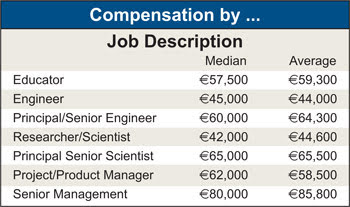Our Fifth European Survey. Little Change in Salary, Benefits
Michael A. Greenwood, News Editor
European workers in the photonics industry in 2006 are generally satisfied with their jobs, enjoy prolonged vacations and earn a better-than-average living with their highly specialized, technical knowledge. No big surprises there. The results have been similar in surveys conducted during the past several years.
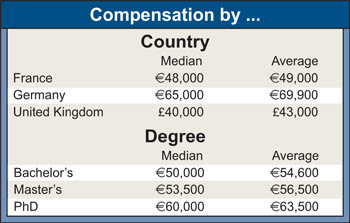
But when the working conditions of those same Europeans are compared with their colleagues in the US, some interesting, even dramatic, differences emerge.For example:
• The average American working in the photonics industry in 2006 is earning considerably more money for the year (about €10,500, or £5,200) than his or her European counterpart.
• The typical European, however, enjoys considerably more time to unwind from the stresses of a high-tech career, with about 10 days, or two weeks, more vacation time each year.
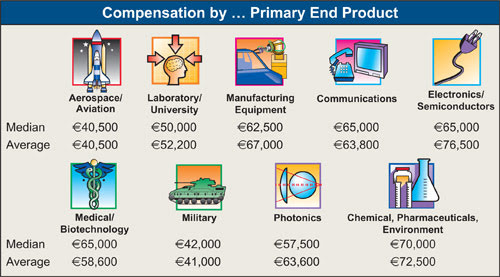 • When it comes time for the annual pay raise, Americans generally pocket a little more, receiving an average raise of 3.6 percent. In Europe, the typical worker realized a 2.7 percent boost.
• When it comes time for the annual pay raise, Americans generally pocket a little more, receiving an average raise of 3.6 percent. In Europe, the typical worker realized a 2.7 percent boost.
• Europeans in the field are generally better educated, with 52 percent holding a PhD, while only 35 percent of their American peers have earned a terminal degree.
• Far more Europeans travel as part of their work. Eighty-seven percent said their job entails at least some travel, while in the US only 63 percent of respondents said they traveled at least once a year.
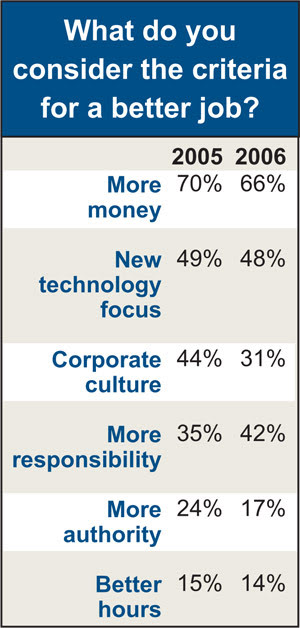 The results are part of Photonics Spectra’s fifth annual survey of Europeans working in photonics-related fields. This year’s statistics reflect responses from 299 workers in three countries: Germany, France and the UK. The same survey was given to 302 American workers earlier this year. Those results appeared in Photonics Spectra in July.
The results are part of Photonics Spectra’s fifth annual survey of Europeans working in photonics-related fields. This year’s statistics reflect responses from 299 workers in three countries: Germany, France and the UK. The same survey was given to 302 American workers earlier this year. Those results appeared in Photonics Spectra in July.
Although American and European workers in the photonics industry may grouse about some differences and take pleasure in others, scientists on either side of the Atlantic delving into the mysteries of the photon also share much in common.
On the gender front, for instance, men still dominate the science of light in Europe, with 93 percent of the photonics work force carrying the Y chromosome. The door is only slightly more ajar for women in the US: 89 percent of the photonics work force is male. The number of women in the field has been increasing on both continents in the past decade, but this progress has been taking place at a glacial pace.
Both Europeans and Americans in the industry toil long hours. In the US, the average workweek is almost 47 hours long or an average of more than nine hours a day. Europeans devote only slightly less time to their jobs, averaging 45 hours of work in a usual week.
In terms of age, Europeans in the industry are just over 45 years old; their American colleague is four years older.
When it comes to job satisfaction, the numbers are once again comparable. More than three-quarters of American workers, 76 percent, are generally satisfied with their jobs. Only 21 percent said they were job hunting. In Europe, the average worker is just slightly more content: 80 percent reported being happy with their employment, while 22 percent said they were actively looking for a new job.
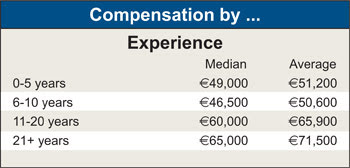 Although worker satisfaction is generally high, that does not prevent some photonics companies from trying to recruit scientific talent from a rival firm. The majority of workers in both Europe and the US report that they have been contacted at least once by a recruiter. Head-hunters are fairly more aggressive in the US, with the average worker receiving 1.8 offers from another company in the past year. In Europe, the average worker received 1.2 such enticements.
Although worker satisfaction is generally high, that does not prevent some photonics companies from trying to recruit scientific talent from a rival firm. The majority of workers in both Europe and the US report that they have been contacted at least once by a recruiter. Head-hunters are fairly more aggressive in the US, with the average worker receiving 1.8 offers from another company in the past year. In Europe, the average worker received 1.2 such enticements.
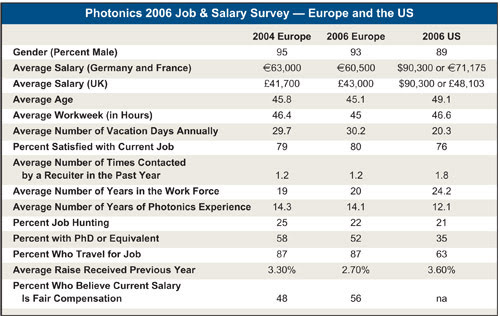 In the last part of the survey, respondents were invited to vent about the most unsatisfying aspect of their job. Many of the answers could have been taken from any industry in any part of the world. One worker was displeased with “low job security” and “unsatisfying tasks,” while others were seeking more challenges, more money and additional company resources. A few complained about the plodding, inefficient bureaucracies at their firms, while another issued a complaint that has been voiced by laborers throughout history: “The workload is too high.”
In the last part of the survey, respondents were invited to vent about the most unsatisfying aspect of their job. Many of the answers could have been taken from any industry in any part of the world. One worker was displeased with “low job security” and “unsatisfying tasks,” while others were seeking more challenges, more money and additional company resources. A few complained about the plodding, inefficient bureaucracies at their firms, while another issued a complaint that has been voiced by laborers throughout history: “The workload is too high.”
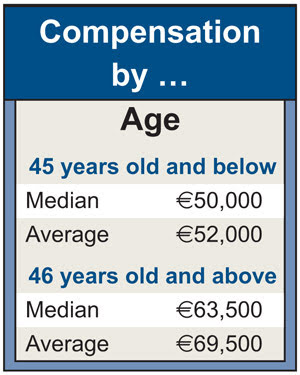 The survey also asked about the toughest problems that workers have encountered in the industry. Nearly everyone had something to say. Responses varied widely, from the rising scientific strength of China to the niche nature of the job where few laymen grasp what it is all about. If a common theme emerged, it was the difficulty of maintaining a competitive edge. Rapid changes in technology, intense competition and the difficulty of finding qualified personnel mean that companies in the photonics industry must work harder than ever to prosper.
The survey also asked about the toughest problems that workers have encountered in the industry. Nearly everyone had something to say. Responses varied widely, from the rising scientific strength of China to the niche nature of the job where few laymen grasp what it is all about. If a common theme emerged, it was the difficulty of maintaining a competitive edge. Rapid changes in technology, intense competition and the difficulty of finding qualified personnel mean that companies in the photonics industry must work harder than ever to prosper.
